Working Ethically and Legally with Aged People: Assessment
VerifiedAdded on 2021/12/07
|28
|6140
|93
Homework Assignment
AI Summary
This assignment provides a comprehensive overview of legal and ethical considerations within aged care services. It delves into various aspects, including codes of conduct, codes of practice, complaint management, and continuing professional education. The assessment covers crucial areas such as discrimination, dignity of risk, and the duty of care. Furthermore, it explores human rights, informed consent, mandatory reporting, and practice standards. The assignment also addresses practitioner/client boundaries, privacy, confidentiality, and policy frameworks. Additionally, it examines records management, the rights and responsibilities of workers, employers, and clients, industrial relations legislation, and work health and safety. The paper also explains the consequences of breaching these ethical and legal considerations. The assignment emphasizes the importance of ethical behavior and legal compliance in providing quality care for the aged population.
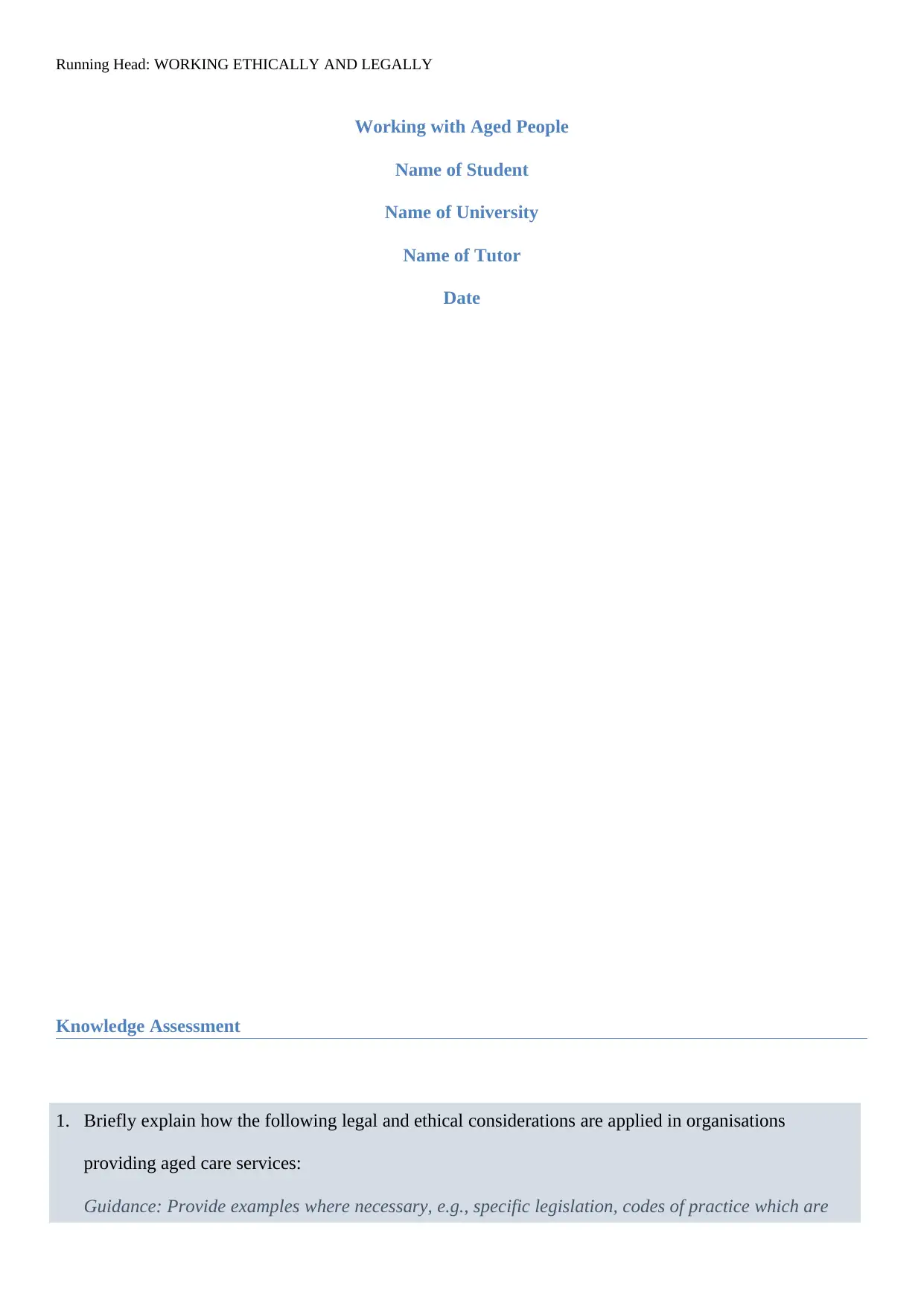
Running Head: WORKING ETHICALLY AND LEGALLY
Working with Aged People
Name of Student
Name of University
Name of Tutor
Date
Knowledge Assessment
1. Briefly explain how the following legal and ethical considerations are applied in organisations
providing aged care services:
Guidance: Provide examples where necessary, e.g., specific legislation, codes of practice which are
Working with Aged People
Name of Student
Name of University
Name of Tutor
Date
Knowledge Assessment
1. Briefly explain how the following legal and ethical considerations are applied in organisations
providing aged care services:
Guidance: Provide examples where necessary, e.g., specific legislation, codes of practice which are
Paraphrase This Document
Need a fresh take? Get an instant paraphrase of this document with our AI Paraphraser
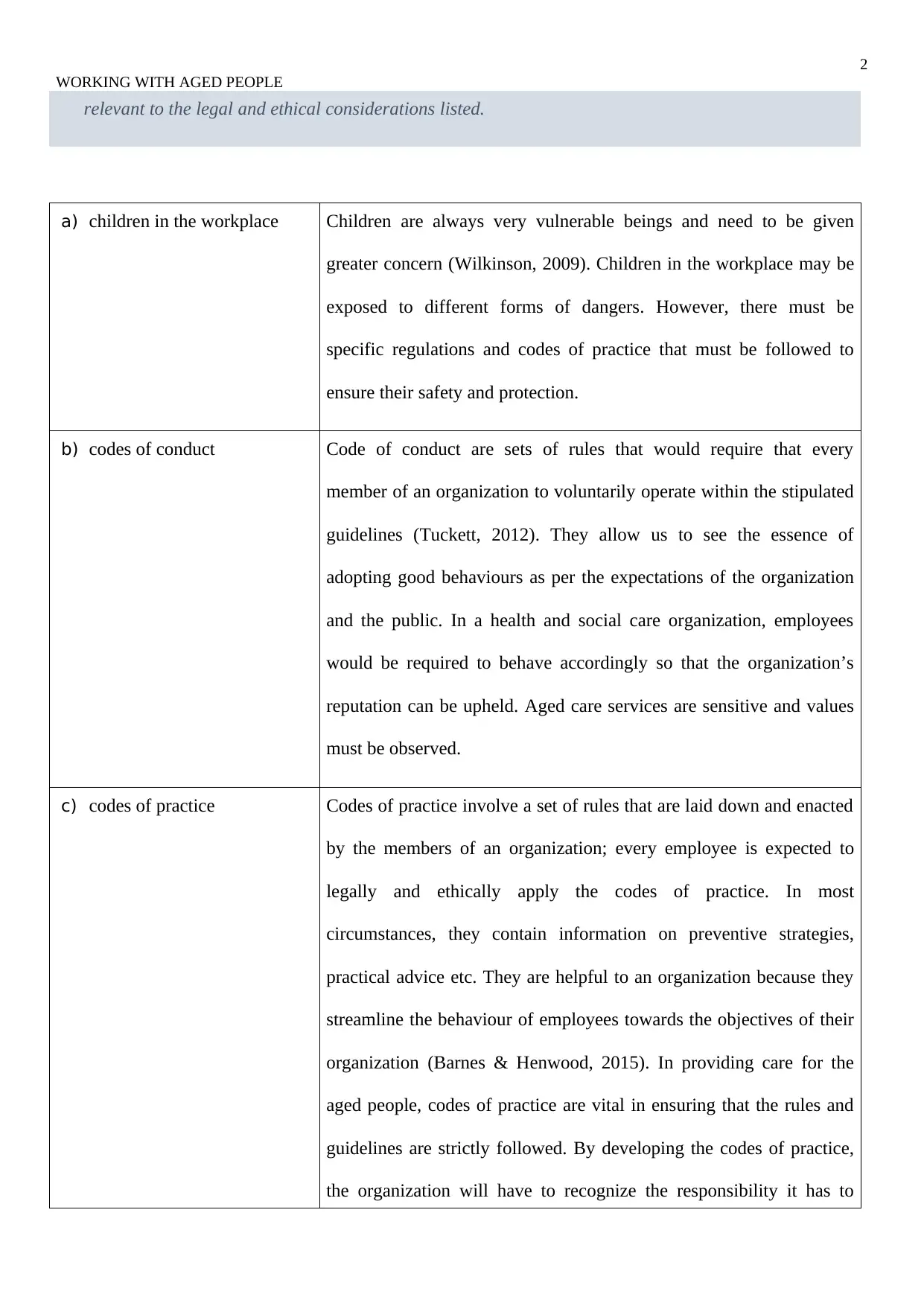
2
WORKING WITH AGED PEOPLE
relevant to the legal and ethical considerations listed.
a) children in the workplace Children are always very vulnerable beings and need to be given
greater concern (Wilkinson, 2009). Children in the workplace may be
exposed to different forms of dangers. However, there must be
specific regulations and codes of practice that must be followed to
ensure their safety and protection.
b) codes of conduct Code of conduct are sets of rules that would require that every
member of an organization to voluntarily operate within the stipulated
guidelines (Tuckett, 2012). They allow us to see the essence of
adopting good behaviours as per the expectations of the organization
and the public. In a health and social care organization, employees
would be required to behave accordingly so that the organization’s
reputation can be upheld. Aged care services are sensitive and values
must be observed.
c) codes of practice Codes of practice involve a set of rules that are laid down and enacted
by the members of an organization; every employee is expected to
legally and ethically apply the codes of practice. In most
circumstances, they contain information on preventive strategies,
practical advice etc. They are helpful to an organization because they
streamline the behaviour of employees towards the objectives of their
organization (Barnes & Henwood, 2015). In providing care for the
aged people, codes of practice are vital in ensuring that the rules and
guidelines are strictly followed. By developing the codes of practice,
the organization will have to recognize the responsibility it has to
WORKING WITH AGED PEOPLE
relevant to the legal and ethical considerations listed.
a) children in the workplace Children are always very vulnerable beings and need to be given
greater concern (Wilkinson, 2009). Children in the workplace may be
exposed to different forms of dangers. However, there must be
specific regulations and codes of practice that must be followed to
ensure their safety and protection.
b) codes of conduct Code of conduct are sets of rules that would require that every
member of an organization to voluntarily operate within the stipulated
guidelines (Tuckett, 2012). They allow us to see the essence of
adopting good behaviours as per the expectations of the organization
and the public. In a health and social care organization, employees
would be required to behave accordingly so that the organization’s
reputation can be upheld. Aged care services are sensitive and values
must be observed.
c) codes of practice Codes of practice involve a set of rules that are laid down and enacted
by the members of an organization; every employee is expected to
legally and ethically apply the codes of practice. In most
circumstances, they contain information on preventive strategies,
practical advice etc. They are helpful to an organization because they
streamline the behaviour of employees towards the objectives of their
organization (Barnes & Henwood, 2015). In providing care for the
aged people, codes of practice are vital in ensuring that the rules and
guidelines are strictly followed. By developing the codes of practice,
the organization will have to recognize the responsibility it has to
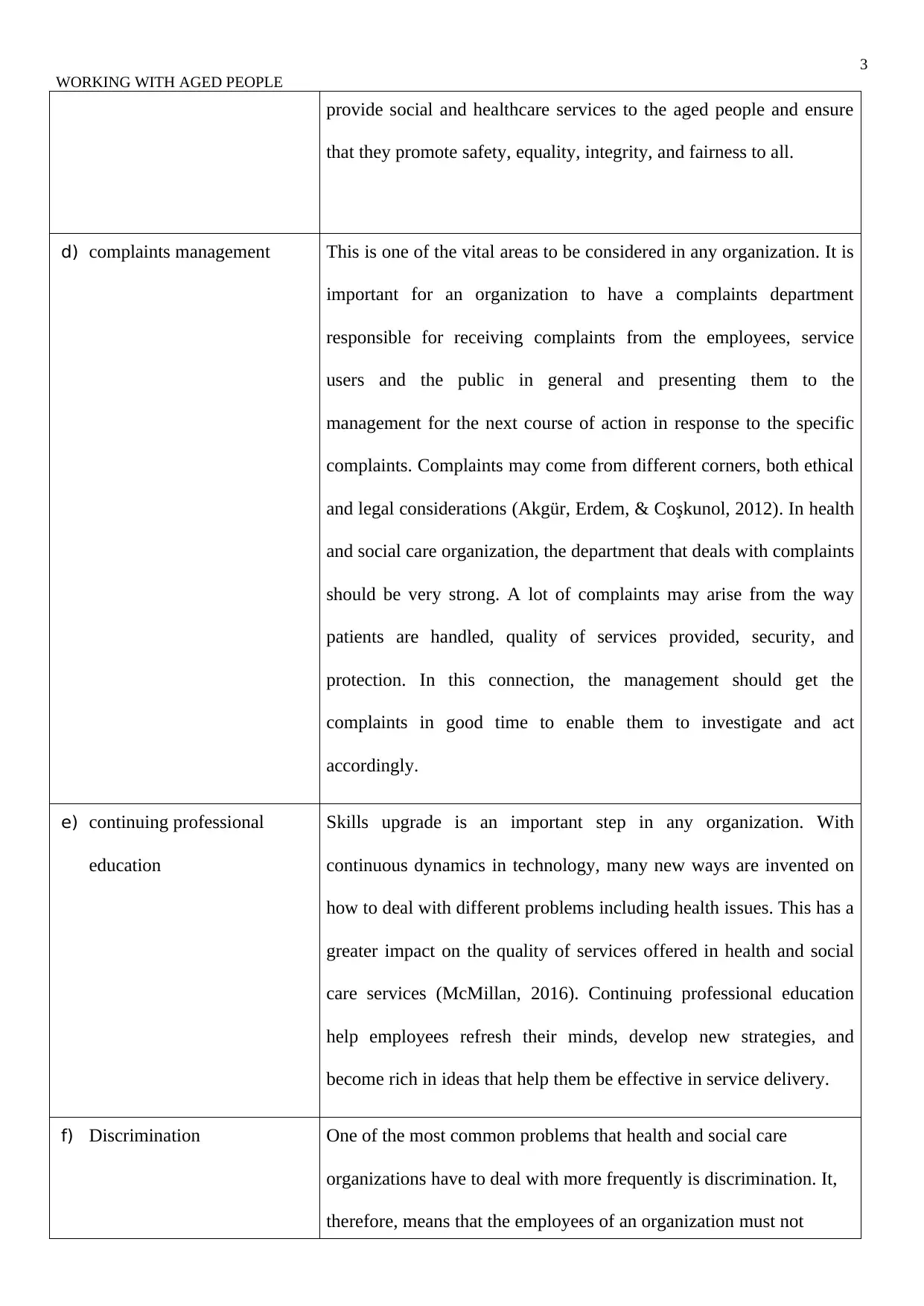
3
WORKING WITH AGED PEOPLE
provide social and healthcare services to the aged people and ensure
that they promote safety, equality, integrity, and fairness to all.
d) complaints management This is one of the vital areas to be considered in any organization. It is
important for an organization to have a complaints department
responsible for receiving complaints from the employees, service
users and the public in general and presenting them to the
management for the next course of action in response to the specific
complaints. Complaints may come from different corners, both ethical
and legal considerations (Akgür, Erdem, & Coşkunol, 2012). In health
and social care organization, the department that deals with complaints
should be very strong. A lot of complaints may arise from the way
patients are handled, quality of services provided, security, and
protection. In this connection, the management should get the
complaints in good time to enable them to investigate and act
accordingly.
e) continuing professional
education
Skills upgrade is an important step in any organization. With
continuous dynamics in technology, many new ways are invented on
how to deal with different problems including health issues. This has a
greater impact on the quality of services offered in health and social
care services (McMillan, 2016). Continuing professional education
help employees refresh their minds, develop new strategies, and
become rich in ideas that help them be effective in service delivery.
f) Discrimination One of the most common problems that health and social care
organizations have to deal with more frequently is discrimination. It,
therefore, means that the employees of an organization must not
WORKING WITH AGED PEOPLE
provide social and healthcare services to the aged people and ensure
that they promote safety, equality, integrity, and fairness to all.
d) complaints management This is one of the vital areas to be considered in any organization. It is
important for an organization to have a complaints department
responsible for receiving complaints from the employees, service
users and the public in general and presenting them to the
management for the next course of action in response to the specific
complaints. Complaints may come from different corners, both ethical
and legal considerations (Akgür, Erdem, & Coşkunol, 2012). In health
and social care organization, the department that deals with complaints
should be very strong. A lot of complaints may arise from the way
patients are handled, quality of services provided, security, and
protection. In this connection, the management should get the
complaints in good time to enable them to investigate and act
accordingly.
e) continuing professional
education
Skills upgrade is an important step in any organization. With
continuous dynamics in technology, many new ways are invented on
how to deal with different problems including health issues. This has a
greater impact on the quality of services offered in health and social
care services (McMillan, 2016). Continuing professional education
help employees refresh their minds, develop new strategies, and
become rich in ideas that help them be effective in service delivery.
f) Discrimination One of the most common problems that health and social care
organizations have to deal with more frequently is discrimination. It,
therefore, means that the employees of an organization must not
⊘ This is a preview!⊘
Do you want full access?
Subscribe today to unlock all pages.

Trusted by 1+ million students worldwide
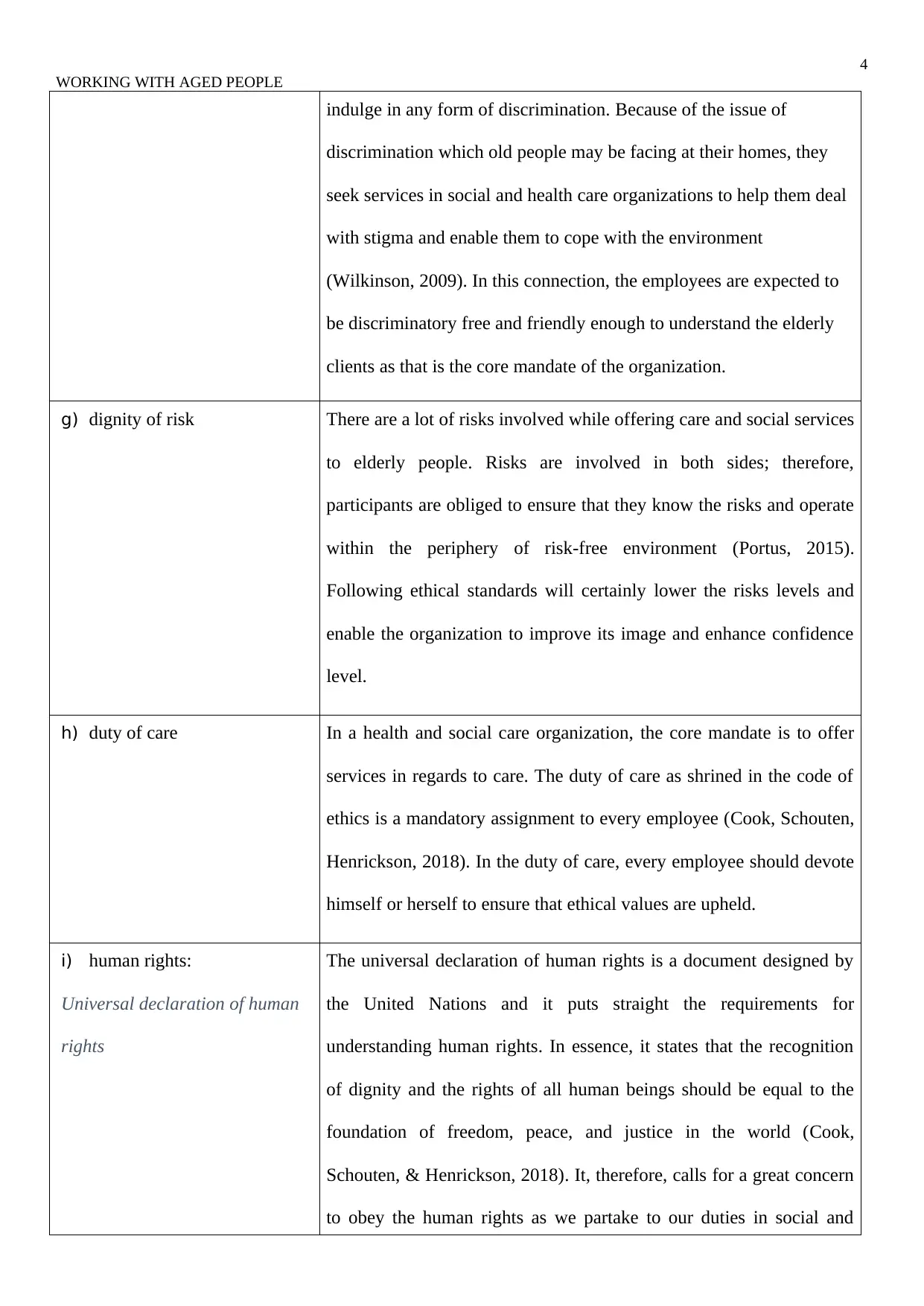
4
WORKING WITH AGED PEOPLE
indulge in any form of discrimination. Because of the issue of
discrimination which old people may be facing at their homes, they
seek services in social and health care organizations to help them deal
with stigma and enable them to cope with the environment
(Wilkinson, 2009). In this connection, the employees are expected to
be discriminatory free and friendly enough to understand the elderly
clients as that is the core mandate of the organization.
g) dignity of risk There are a lot of risks involved while offering care and social services
to elderly people. Risks are involved in both sides; therefore,
participants are obliged to ensure that they know the risks and operate
within the periphery of risk-free environment (Portus, 2015).
Following ethical standards will certainly lower the risks levels and
enable the organization to improve its image and enhance confidence
level.
h) duty of care In a health and social care organization, the core mandate is to offer
services in regards to care. The duty of care as shrined in the code of
ethics is a mandatory assignment to every employee (Cook, Schouten,
Henrickson, 2018). In the duty of care, every employee should devote
himself or herself to ensure that ethical values are upheld.
i) human rights:
Universal declaration of human
rights
The universal declaration of human rights is a document designed by
the United Nations and it puts straight the requirements for
understanding human rights. In essence, it states that the recognition
of dignity and the rights of all human beings should be equal to the
foundation of freedom, peace, and justice in the world (Cook,
Schouten, & Henrickson, 2018). It, therefore, calls for a great concern
to obey the human rights as we partake to our duties in social and
WORKING WITH AGED PEOPLE
indulge in any form of discrimination. Because of the issue of
discrimination which old people may be facing at their homes, they
seek services in social and health care organizations to help them deal
with stigma and enable them to cope with the environment
(Wilkinson, 2009). In this connection, the employees are expected to
be discriminatory free and friendly enough to understand the elderly
clients as that is the core mandate of the organization.
g) dignity of risk There are a lot of risks involved while offering care and social services
to elderly people. Risks are involved in both sides; therefore,
participants are obliged to ensure that they know the risks and operate
within the periphery of risk-free environment (Portus, 2015).
Following ethical standards will certainly lower the risks levels and
enable the organization to improve its image and enhance confidence
level.
h) duty of care In a health and social care organization, the core mandate is to offer
services in regards to care. The duty of care as shrined in the code of
ethics is a mandatory assignment to every employee (Cook, Schouten,
Henrickson, 2018). In the duty of care, every employee should devote
himself or herself to ensure that ethical values are upheld.
i) human rights:
Universal declaration of human
rights
The universal declaration of human rights is a document designed by
the United Nations and it puts straight the requirements for
understanding human rights. In essence, it states that the recognition
of dignity and the rights of all human beings should be equal to the
foundation of freedom, peace, and justice in the world (Cook,
Schouten, & Henrickson, 2018). It, therefore, calls for a great concern
to obey the human rights as we partake to our duties in social and
Paraphrase This Document
Need a fresh take? Get an instant paraphrase of this document with our AI Paraphraser
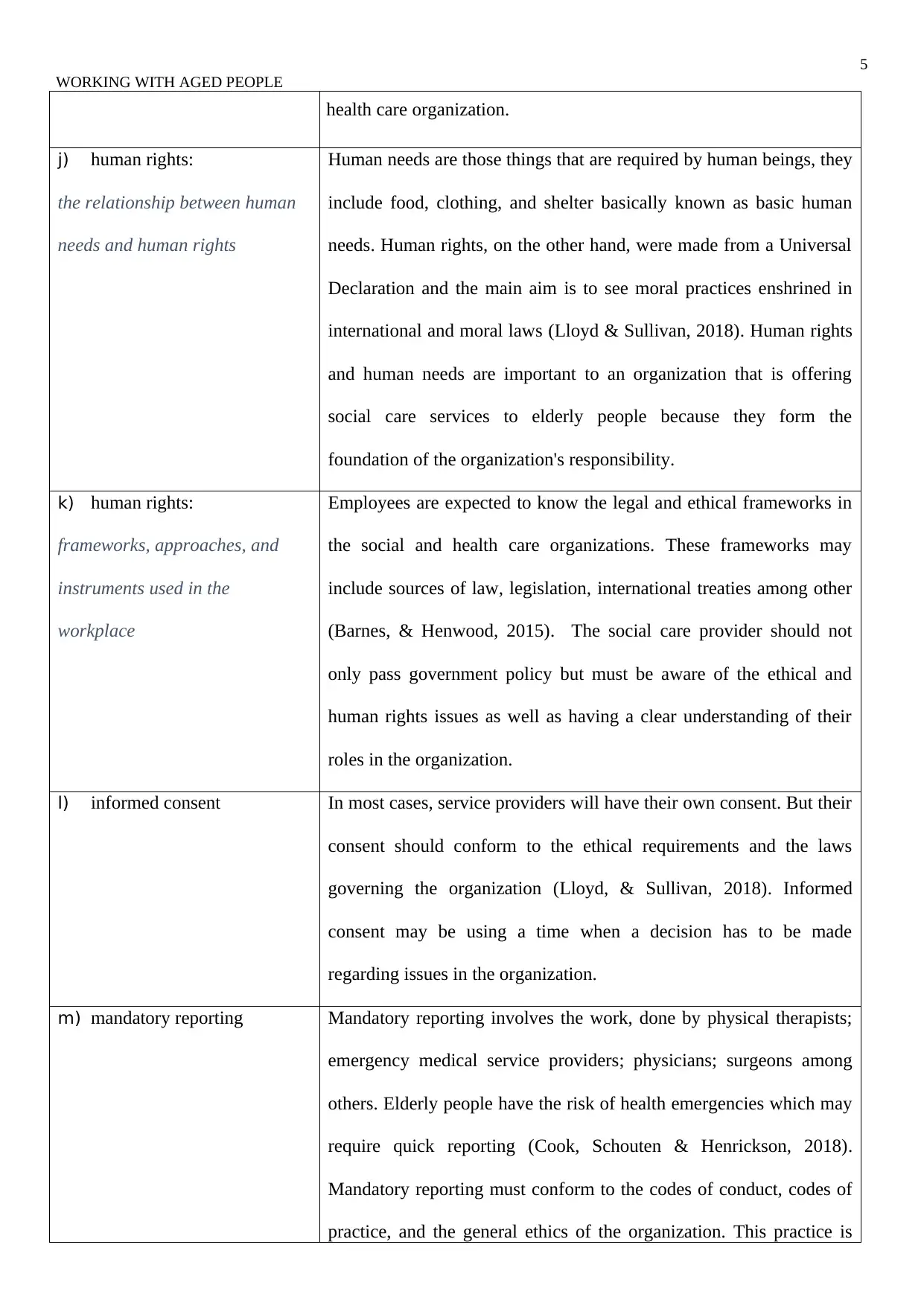
5
WORKING WITH AGED PEOPLE
health care organization.
j) human rights:
the relationship between human
needs and human rights
Human needs are those things that are required by human beings, they
include food, clothing, and shelter basically known as basic human
needs. Human rights, on the other hand, were made from a Universal
Declaration and the main aim is to see moral practices enshrined in
international and moral laws (Lloyd & Sullivan, 2018). Human rights
and human needs are important to an organization that is offering
social care services to elderly people because they form the
foundation of the organization's responsibility.
k) human rights:
frameworks, approaches, and
instruments used in the
workplace
Employees are expected to know the legal and ethical frameworks in
the social and health care organizations. These frameworks may
include sources of law, legislation, international treaties among other
(Barnes, & Henwood, 2015). The social care provider should not
only pass government policy but must be aware of the ethical and
human rights issues as well as having a clear understanding of their
roles in the organization.
l) informed consent In most cases, service providers will have their own consent. But their
consent should conform to the ethical requirements and the laws
governing the organization (Lloyd, & Sullivan, 2018). Informed
consent may be using a time when a decision has to be made
regarding issues in the organization.
m) mandatory reporting Mandatory reporting involves the work, done by physical therapists;
emergency medical service providers; physicians; surgeons among
others. Elderly people have the risk of health emergencies which may
require quick reporting (Cook, Schouten & Henrickson, 2018).
Mandatory reporting must conform to the codes of conduct, codes of
practice, and the general ethics of the organization. This practice is
WORKING WITH AGED PEOPLE
health care organization.
j) human rights:
the relationship between human
needs and human rights
Human needs are those things that are required by human beings, they
include food, clothing, and shelter basically known as basic human
needs. Human rights, on the other hand, were made from a Universal
Declaration and the main aim is to see moral practices enshrined in
international and moral laws (Lloyd & Sullivan, 2018). Human rights
and human needs are important to an organization that is offering
social care services to elderly people because they form the
foundation of the organization's responsibility.
k) human rights:
frameworks, approaches, and
instruments used in the
workplace
Employees are expected to know the legal and ethical frameworks in
the social and health care organizations. These frameworks may
include sources of law, legislation, international treaties among other
(Barnes, & Henwood, 2015). The social care provider should not
only pass government policy but must be aware of the ethical and
human rights issues as well as having a clear understanding of their
roles in the organization.
l) informed consent In most cases, service providers will have their own consent. But their
consent should conform to the ethical requirements and the laws
governing the organization (Lloyd, & Sullivan, 2018). Informed
consent may be using a time when a decision has to be made
regarding issues in the organization.
m) mandatory reporting Mandatory reporting involves the work, done by physical therapists;
emergency medical service providers; physicians; surgeons among
others. Elderly people have the risk of health emergencies which may
require quick reporting (Cook, Schouten & Henrickson, 2018).
Mandatory reporting must conform to the codes of conduct, codes of
practice, and the general ethics of the organization. This practice is
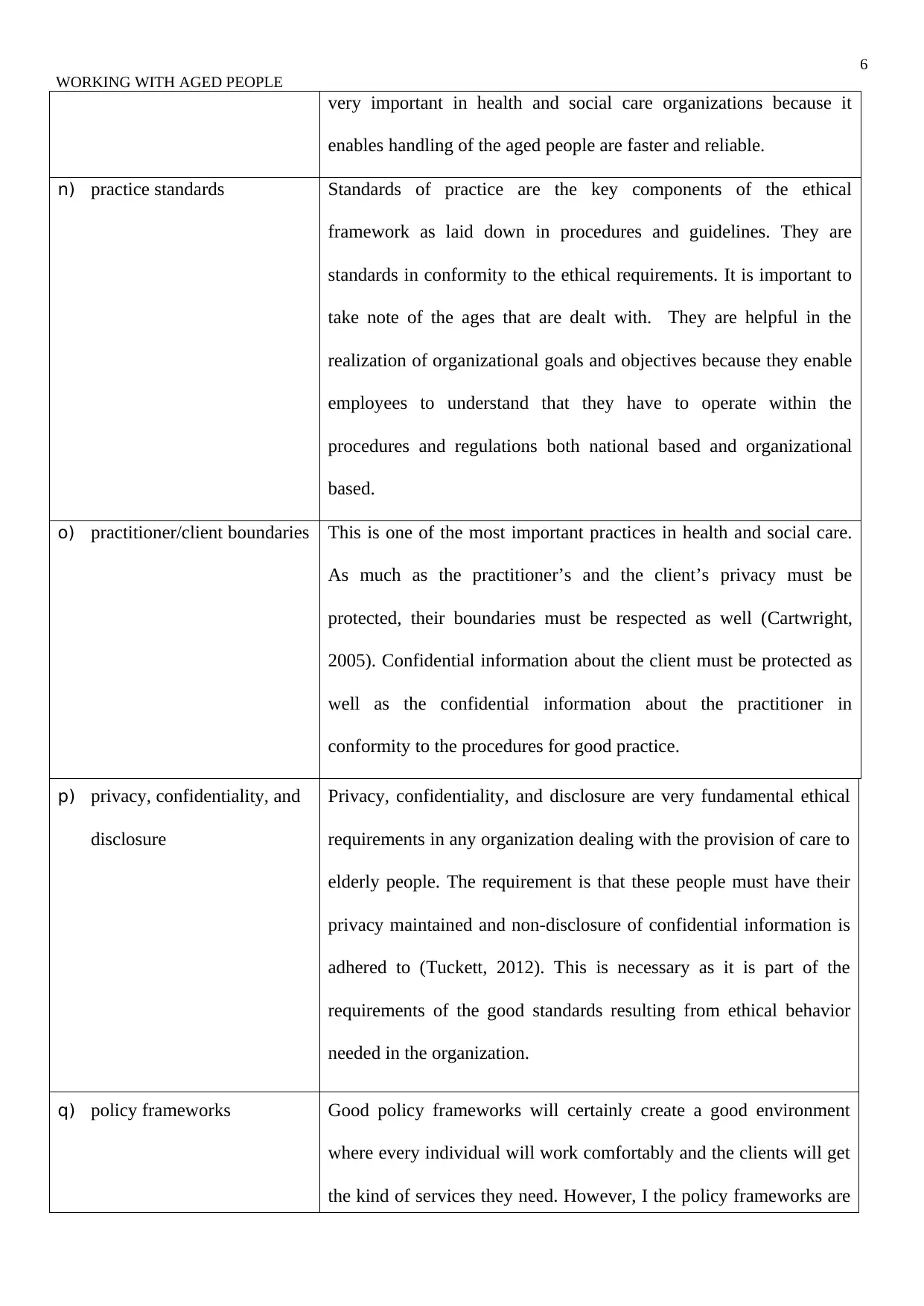
6
WORKING WITH AGED PEOPLE
very important in health and social care organizations because it
enables handling of the aged people are faster and reliable.
n) practice standards Standards of practice are the key components of the ethical
framework as laid down in procedures and guidelines. They are
standards in conformity to the ethical requirements. It is important to
take note of the ages that are dealt with. They are helpful in the
realization of organizational goals and objectives because they enable
employees to understand that they have to operate within the
procedures and regulations both national based and organizational
based.
o) practitioner/client boundaries This is one of the most important practices in health and social care.
As much as the practitioner’s and the client’s privacy must be
protected, their boundaries must be respected as well (Cartwright,
2005). Confidential information about the client must be protected as
well as the confidential information about the practitioner in
conformity to the procedures for good practice.
p) privacy, confidentiality, and
disclosure
Privacy, confidentiality, and disclosure are very fundamental ethical
requirements in any organization dealing with the provision of care to
elderly people. The requirement is that these people must have their
privacy maintained and non-disclosure of confidential information is
adhered to (Tuckett, 2012). This is necessary as it is part of the
requirements of the good standards resulting from ethical behavior
needed in the organization.
q) policy frameworks Good policy frameworks will certainly create a good environment
where every individual will work comfortably and the clients will get
the kind of services they need. However, I the policy frameworks are
WORKING WITH AGED PEOPLE
very important in health and social care organizations because it
enables handling of the aged people are faster and reliable.
n) practice standards Standards of practice are the key components of the ethical
framework as laid down in procedures and guidelines. They are
standards in conformity to the ethical requirements. It is important to
take note of the ages that are dealt with. They are helpful in the
realization of organizational goals and objectives because they enable
employees to understand that they have to operate within the
procedures and regulations both national based and organizational
based.
o) practitioner/client boundaries This is one of the most important practices in health and social care.
As much as the practitioner’s and the client’s privacy must be
protected, their boundaries must be respected as well (Cartwright,
2005). Confidential information about the client must be protected as
well as the confidential information about the practitioner in
conformity to the procedures for good practice.
p) privacy, confidentiality, and
disclosure
Privacy, confidentiality, and disclosure are very fundamental ethical
requirements in any organization dealing with the provision of care to
elderly people. The requirement is that these people must have their
privacy maintained and non-disclosure of confidential information is
adhered to (Tuckett, 2012). This is necessary as it is part of the
requirements of the good standards resulting from ethical behavior
needed in the organization.
q) policy frameworks Good policy frameworks will certainly create a good environment
where every individual will work comfortably and the clients will get
the kind of services they need. However, I the policy frameworks are
⊘ This is a preview!⊘
Do you want full access?
Subscribe today to unlock all pages.

Trusted by 1+ million students worldwide
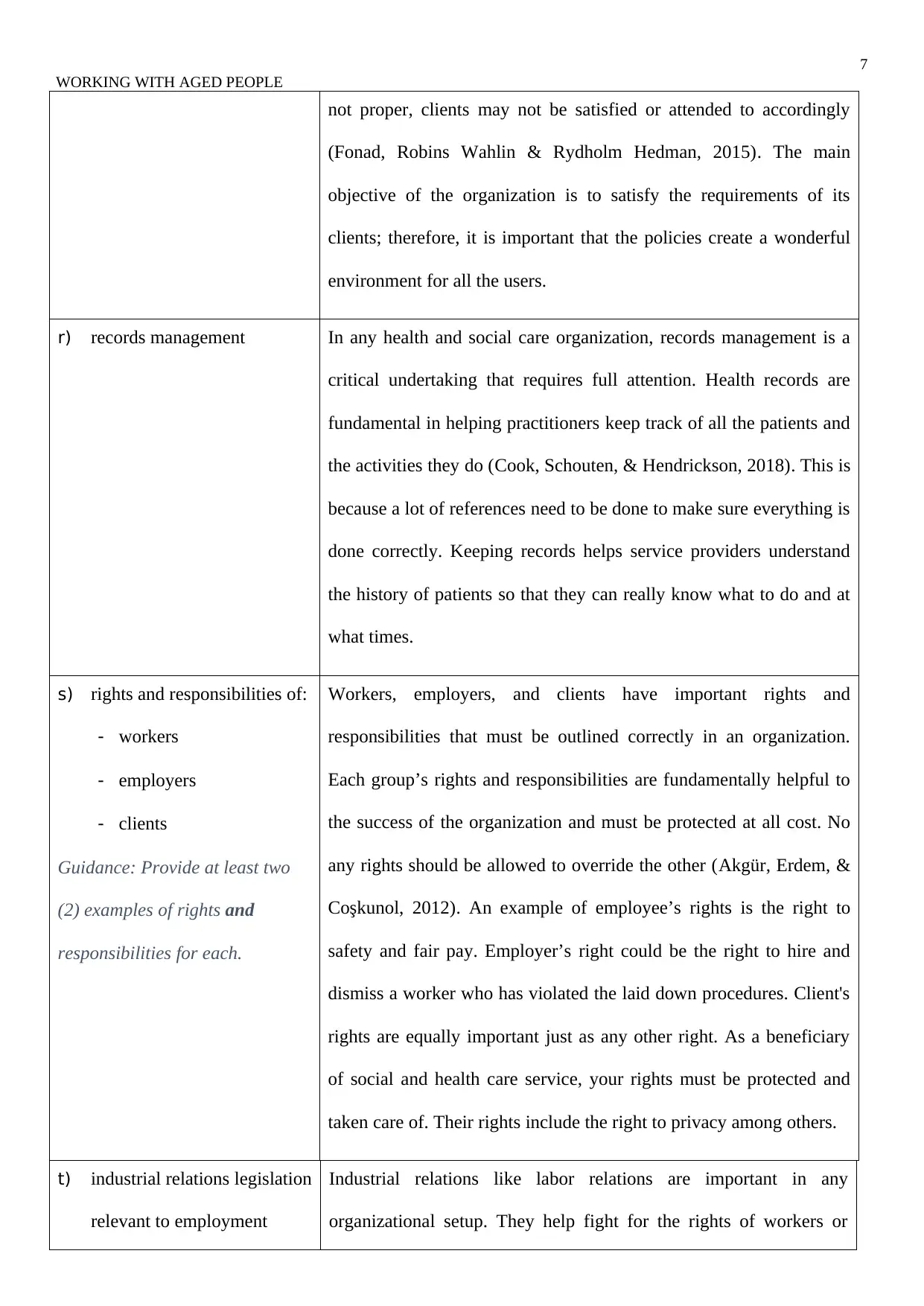
7
WORKING WITH AGED PEOPLE
not proper, clients may not be satisfied or attended to accordingly
(Fonad, Robins Wahlin & Rydholm Hedman, 2015). The main
objective of the organization is to satisfy the requirements of its
clients; therefore, it is important that the policies create a wonderful
environment for all the users.
r) records management In any health and social care organization, records management is a
critical undertaking that requires full attention. Health records are
fundamental in helping practitioners keep track of all the patients and
the activities they do (Cook, Schouten, & Hendrickson, 2018). This is
because a lot of references need to be done to make sure everything is
done correctly. Keeping records helps service providers understand
the history of patients so that they can really know what to do and at
what times.
s) rights and responsibilities of:
- workers
- employers
- clients
Guidance: Provide at least two
(2) examples of rights and
responsibilities for each.
Workers, employers, and clients have important rights and
responsibilities that must be outlined correctly in an organization.
Each group’s rights and responsibilities are fundamentally helpful to
the success of the organization and must be protected at all cost. No
any rights should be allowed to override the other (Akgür, Erdem, &
Coşkunol, 2012). An example of employee’s rights is the right to
safety and fair pay. Employer’s right could be the right to hire and
dismiss a worker who has violated the laid down procedures. Client's
rights are equally important just as any other right. As a beneficiary
of social and health care service, your rights must be protected and
taken care of. Their rights include the right to privacy among others.
t) industrial relations legislation
relevant to employment
Industrial relations like labor relations are important in any
organizational setup. They help fight for the rights of workers or
WORKING WITH AGED PEOPLE
not proper, clients may not be satisfied or attended to accordingly
(Fonad, Robins Wahlin & Rydholm Hedman, 2015). The main
objective of the organization is to satisfy the requirements of its
clients; therefore, it is important that the policies create a wonderful
environment for all the users.
r) records management In any health and social care organization, records management is a
critical undertaking that requires full attention. Health records are
fundamental in helping practitioners keep track of all the patients and
the activities they do (Cook, Schouten, & Hendrickson, 2018). This is
because a lot of references need to be done to make sure everything is
done correctly. Keeping records helps service providers understand
the history of patients so that they can really know what to do and at
what times.
s) rights and responsibilities of:
- workers
- employers
- clients
Guidance: Provide at least two
(2) examples of rights and
responsibilities for each.
Workers, employers, and clients have important rights and
responsibilities that must be outlined correctly in an organization.
Each group’s rights and responsibilities are fundamentally helpful to
the success of the organization and must be protected at all cost. No
any rights should be allowed to override the other (Akgür, Erdem, &
Coşkunol, 2012). An example of employee’s rights is the right to
safety and fair pay. Employer’s right could be the right to hire and
dismiss a worker who has violated the laid down procedures. Client's
rights are equally important just as any other right. As a beneficiary
of social and health care service, your rights must be protected and
taken care of. Their rights include the right to privacy among others.
t) industrial relations legislation
relevant to employment
Industrial relations like labor relations are important in any
organizational setup. They help fight for the rights of workers or
Paraphrase This Document
Need a fresh take? Get an instant paraphrase of this document with our AI Paraphraser
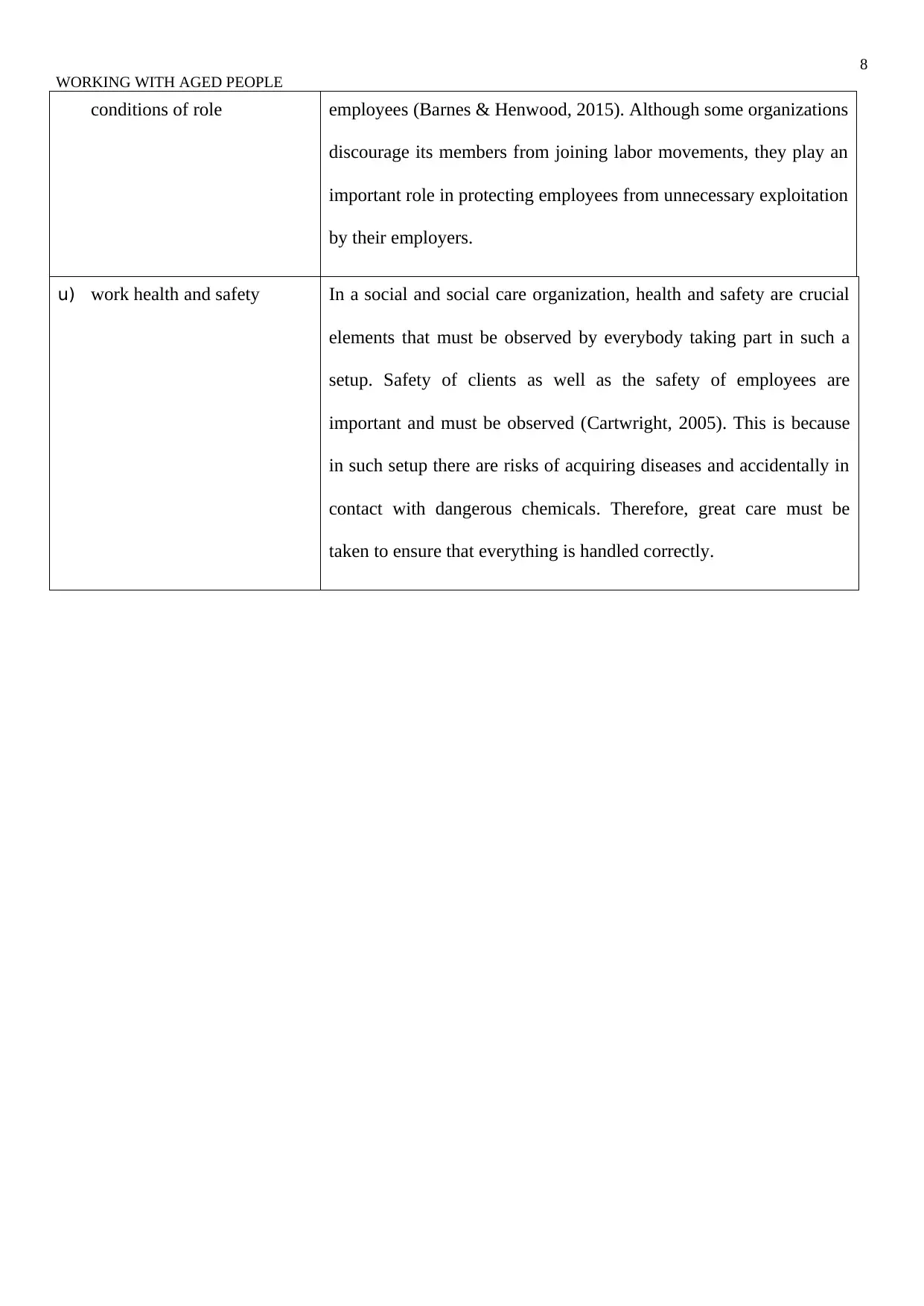
8
WORKING WITH AGED PEOPLE
conditions of role employees (Barnes & Henwood, 2015). Although some organizations
discourage its members from joining labor movements, they play an
important role in protecting employees from unnecessary exploitation
by their employers.
u) work health and safety In a social and social care organization, health and safety are crucial
elements that must be observed by everybody taking part in such a
setup. Safety of clients as well as the safety of employees are
important and must be observed (Cartwright, 2005). This is because
in such setup there are risks of acquiring diseases and accidentally in
contact with dangerous chemicals. Therefore, great care must be
taken to ensure that everything is handled correctly.
WORKING WITH AGED PEOPLE
conditions of role employees (Barnes & Henwood, 2015). Although some organizations
discourage its members from joining labor movements, they play an
important role in protecting employees from unnecessary exploitation
by their employers.
u) work health and safety In a social and social care organization, health and safety are crucial
elements that must be observed by everybody taking part in such a
setup. Safety of clients as well as the safety of employees are
important and must be observed (Cartwright, 2005). This is because
in such setup there are risks of acquiring diseases and accidentally in
contact with dangerous chemicals. Therefore, great care must be
taken to ensure that everything is handled correctly.
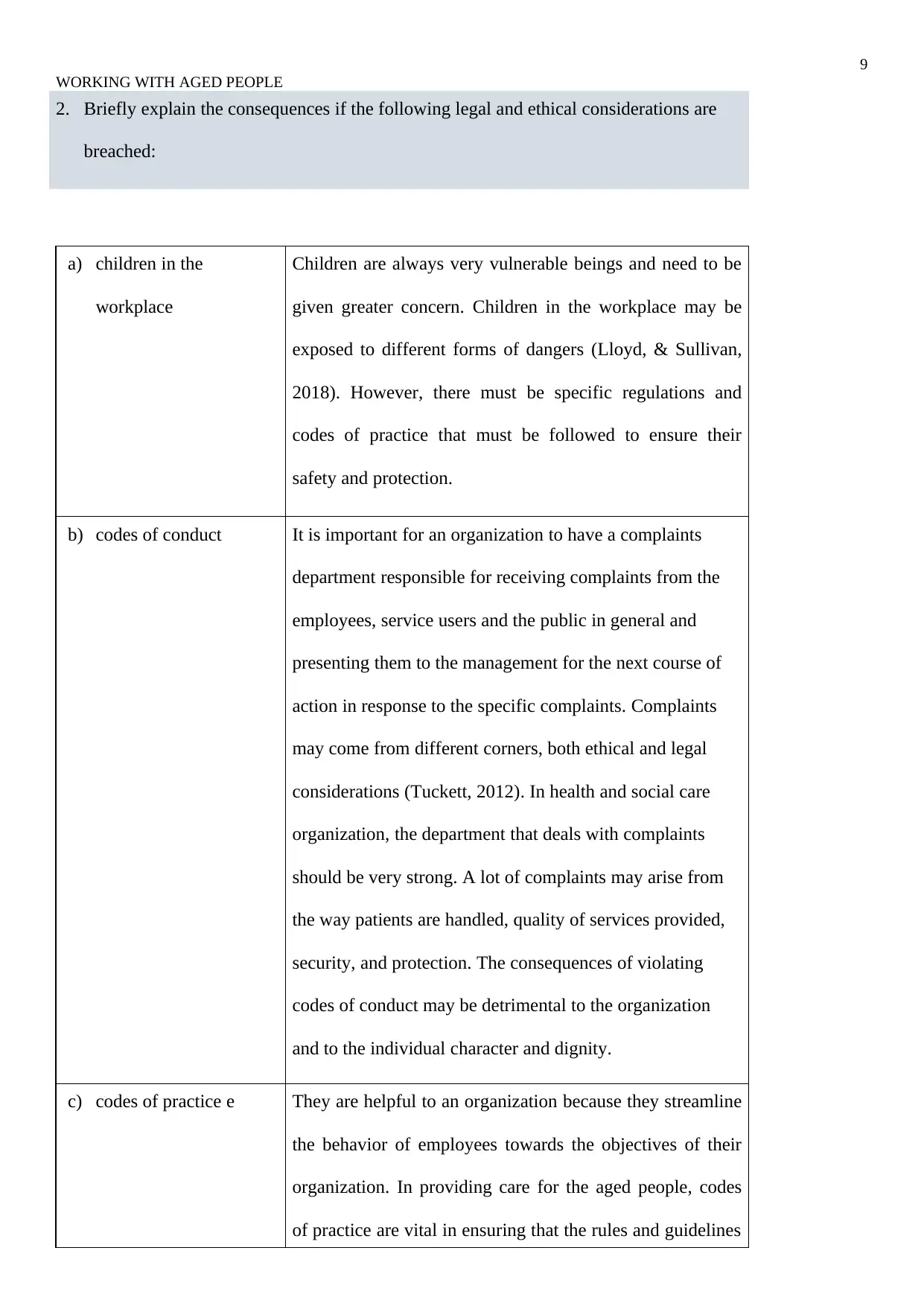
9
WORKING WITH AGED PEOPLE
2. Briefly explain the consequences if the following legal and ethical considerations are
breached:
a) children in the
workplace
Children are always very vulnerable beings and need to be
given greater concern. Children in the workplace may be
exposed to different forms of dangers (Lloyd, & Sullivan,
2018). However, there must be specific regulations and
codes of practice that must be followed to ensure their
safety and protection.
b) codes of conduct It is important for an organization to have a complaints
department responsible for receiving complaints from the
employees, service users and the public in general and
presenting them to the management for the next course of
action in response to the specific complaints. Complaints
may come from different corners, both ethical and legal
considerations (Tuckett, 2012). In health and social care
organization, the department that deals with complaints
should be very strong. A lot of complaints may arise from
the way patients are handled, quality of services provided,
security, and protection. The consequences of violating
codes of conduct may be detrimental to the organization
and to the individual character and dignity.
c) codes of practice e They are helpful to an organization because they streamline
the behavior of employees towards the objectives of their
organization. In providing care for the aged people, codes
of practice are vital in ensuring that the rules and guidelines
WORKING WITH AGED PEOPLE
2. Briefly explain the consequences if the following legal and ethical considerations are
breached:
a) children in the
workplace
Children are always very vulnerable beings and need to be
given greater concern. Children in the workplace may be
exposed to different forms of dangers (Lloyd, & Sullivan,
2018). However, there must be specific regulations and
codes of practice that must be followed to ensure their
safety and protection.
b) codes of conduct It is important for an organization to have a complaints
department responsible for receiving complaints from the
employees, service users and the public in general and
presenting them to the management for the next course of
action in response to the specific complaints. Complaints
may come from different corners, both ethical and legal
considerations (Tuckett, 2012). In health and social care
organization, the department that deals with complaints
should be very strong. A lot of complaints may arise from
the way patients are handled, quality of services provided,
security, and protection. The consequences of violating
codes of conduct may be detrimental to the organization
and to the individual character and dignity.
c) codes of practice e They are helpful to an organization because they streamline
the behavior of employees towards the objectives of their
organization. In providing care for the aged people, codes
of practice are vital in ensuring that the rules and guidelines
⊘ This is a preview!⊘
Do you want full access?
Subscribe today to unlock all pages.

Trusted by 1+ million students worldwide
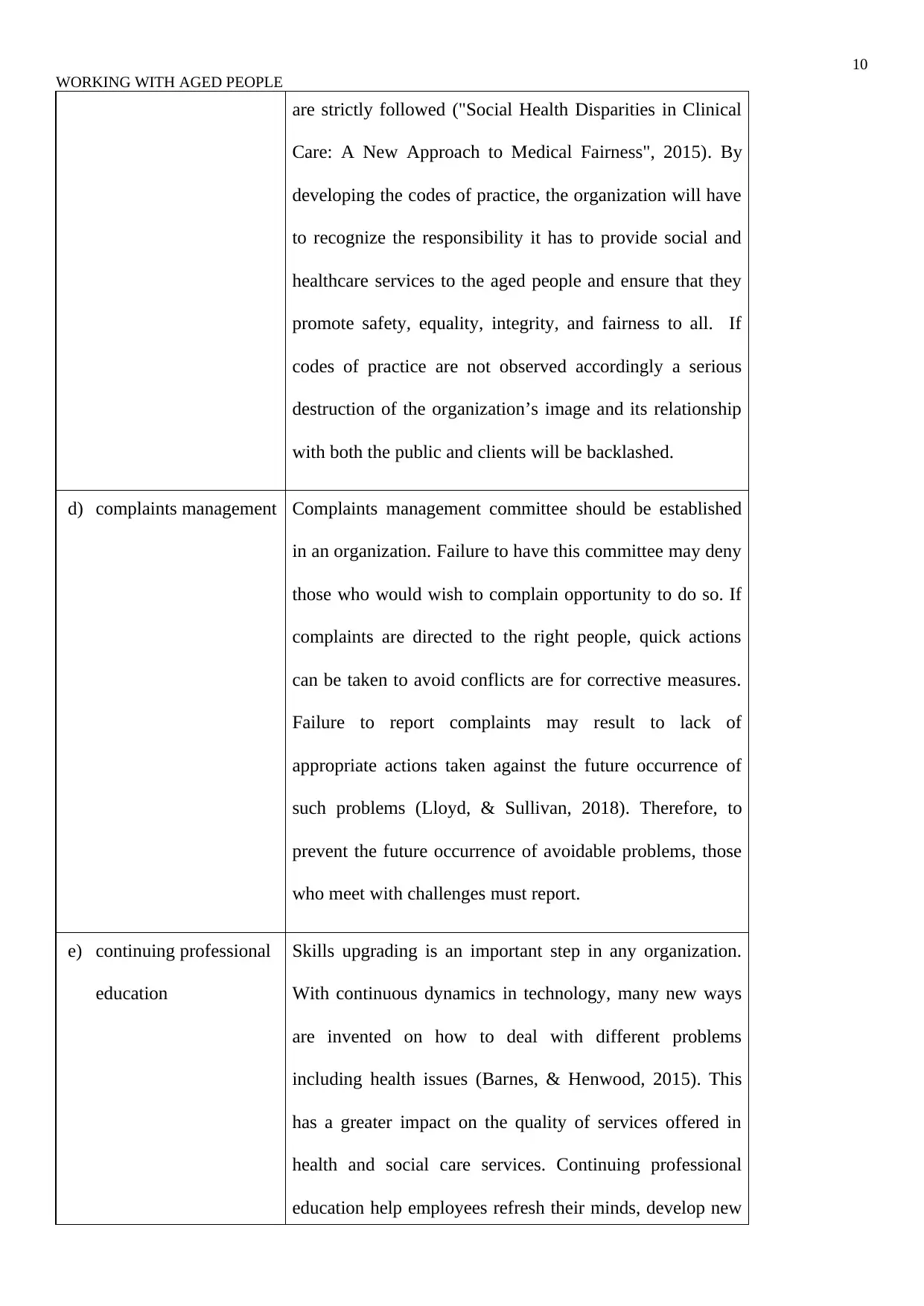
10
WORKING WITH AGED PEOPLE
are strictly followed ("Social Health Disparities in Clinical
Care: A New Approach to Medical Fairness", 2015). By
developing the codes of practice, the organization will have
to recognize the responsibility it has to provide social and
healthcare services to the aged people and ensure that they
promote safety, equality, integrity, and fairness to all. If
codes of practice are not observed accordingly a serious
destruction of the organization’s image and its relationship
with both the public and clients will be backlashed.
d) complaints management Complaints management committee should be established
in an organization. Failure to have this committee may deny
those who would wish to complain opportunity to do so. If
complaints are directed to the right people, quick actions
can be taken to avoid conflicts are for corrective measures.
Failure to report complaints may result to lack of
appropriate actions taken against the future occurrence of
such problems (Lloyd, & Sullivan, 2018). Therefore, to
prevent the future occurrence of avoidable problems, those
who meet with challenges must report.
e) continuing professional
education
Skills upgrading is an important step in any organization.
With continuous dynamics in technology, many new ways
are invented on how to deal with different problems
including health issues (Barnes, & Henwood, 2015). This
has a greater impact on the quality of services offered in
health and social care services. Continuing professional
education help employees refresh their minds, develop new
WORKING WITH AGED PEOPLE
are strictly followed ("Social Health Disparities in Clinical
Care: A New Approach to Medical Fairness", 2015). By
developing the codes of practice, the organization will have
to recognize the responsibility it has to provide social and
healthcare services to the aged people and ensure that they
promote safety, equality, integrity, and fairness to all. If
codes of practice are not observed accordingly a serious
destruction of the organization’s image and its relationship
with both the public and clients will be backlashed.
d) complaints management Complaints management committee should be established
in an organization. Failure to have this committee may deny
those who would wish to complain opportunity to do so. If
complaints are directed to the right people, quick actions
can be taken to avoid conflicts are for corrective measures.
Failure to report complaints may result to lack of
appropriate actions taken against the future occurrence of
such problems (Lloyd, & Sullivan, 2018). Therefore, to
prevent the future occurrence of avoidable problems, those
who meet with challenges must report.
e) continuing professional
education
Skills upgrading is an important step in any organization.
With continuous dynamics in technology, many new ways
are invented on how to deal with different problems
including health issues (Barnes, & Henwood, 2015). This
has a greater impact on the quality of services offered in
health and social care services. Continuing professional
education help employees refresh their minds, develop new
Paraphrase This Document
Need a fresh take? Get an instant paraphrase of this document with our AI Paraphraser
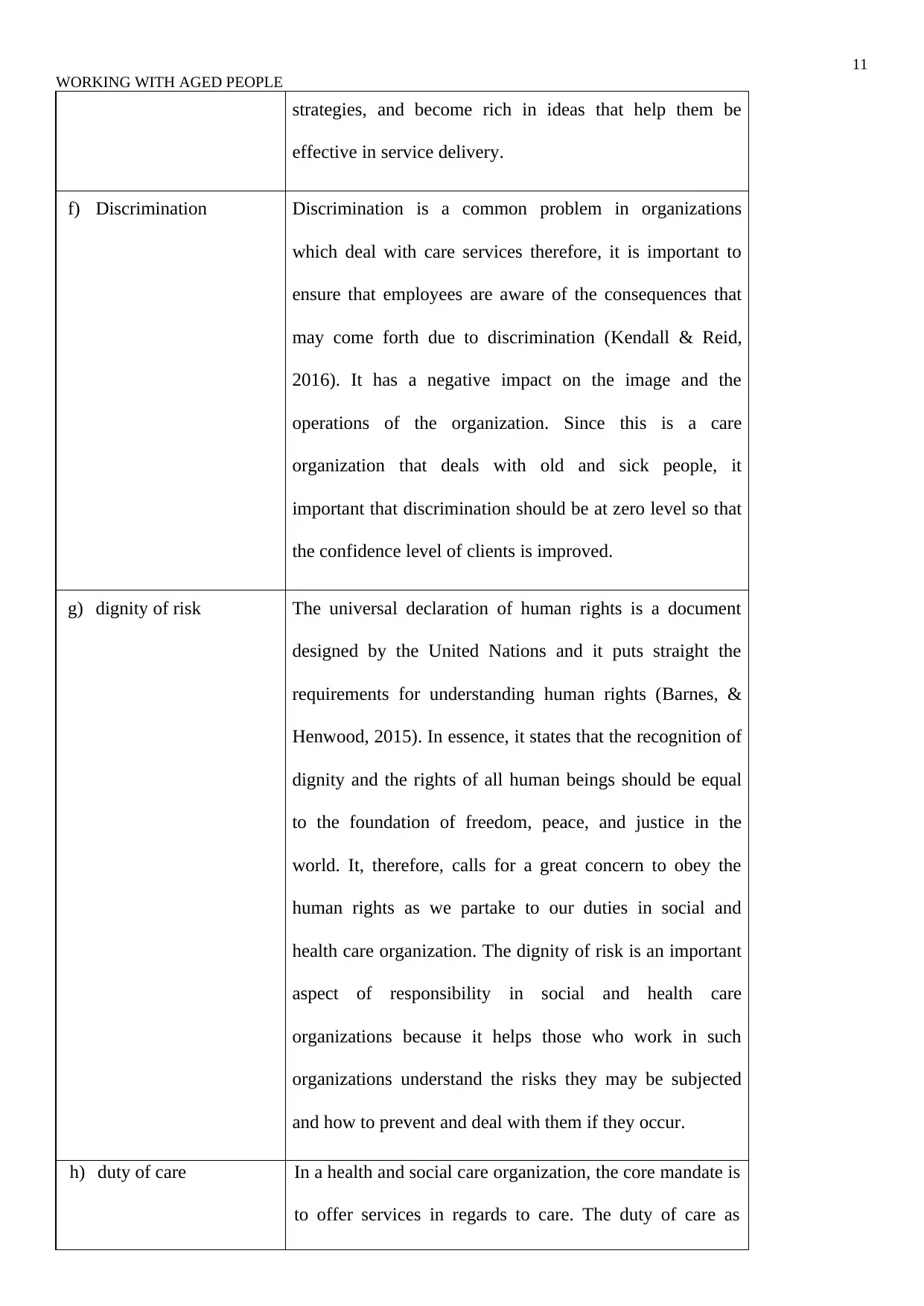
11
WORKING WITH AGED PEOPLE
strategies, and become rich in ideas that help them be
effective in service delivery.
f) Discrimination Discrimination is a common problem in organizations
which deal with care services therefore, it is important to
ensure that employees are aware of the consequences that
may come forth due to discrimination (Kendall & Reid,
2016). It has a negative impact on the image and the
operations of the organization. Since this is a care
organization that deals with old and sick people, it
important that discrimination should be at zero level so that
the confidence level of clients is improved.
g) dignity of risk The universal declaration of human rights is a document
designed by the United Nations and it puts straight the
requirements for understanding human rights (Barnes, &
Henwood, 2015). In essence, it states that the recognition of
dignity and the rights of all human beings should be equal
to the foundation of freedom, peace, and justice in the
world. It, therefore, calls for a great concern to obey the
human rights as we partake to our duties in social and
health care organization. The dignity of risk is an important
aspect of responsibility in social and health care
organizations because it helps those who work in such
organizations understand the risks they may be subjected
and how to prevent and deal with them if they occur.
h) duty of care In a health and social care organization, the core mandate is
to offer services in regards to care. The duty of care as
WORKING WITH AGED PEOPLE
strategies, and become rich in ideas that help them be
effective in service delivery.
f) Discrimination Discrimination is a common problem in organizations
which deal with care services therefore, it is important to
ensure that employees are aware of the consequences that
may come forth due to discrimination (Kendall & Reid,
2016). It has a negative impact on the image and the
operations of the organization. Since this is a care
organization that deals with old and sick people, it
important that discrimination should be at zero level so that
the confidence level of clients is improved.
g) dignity of risk The universal declaration of human rights is a document
designed by the United Nations and it puts straight the
requirements for understanding human rights (Barnes, &
Henwood, 2015). In essence, it states that the recognition of
dignity and the rights of all human beings should be equal
to the foundation of freedom, peace, and justice in the
world. It, therefore, calls for a great concern to obey the
human rights as we partake to our duties in social and
health care organization. The dignity of risk is an important
aspect of responsibility in social and health care
organizations because it helps those who work in such
organizations understand the risks they may be subjected
and how to prevent and deal with them if they occur.
h) duty of care In a health and social care organization, the core mandate is
to offer services in regards to care. The duty of care as
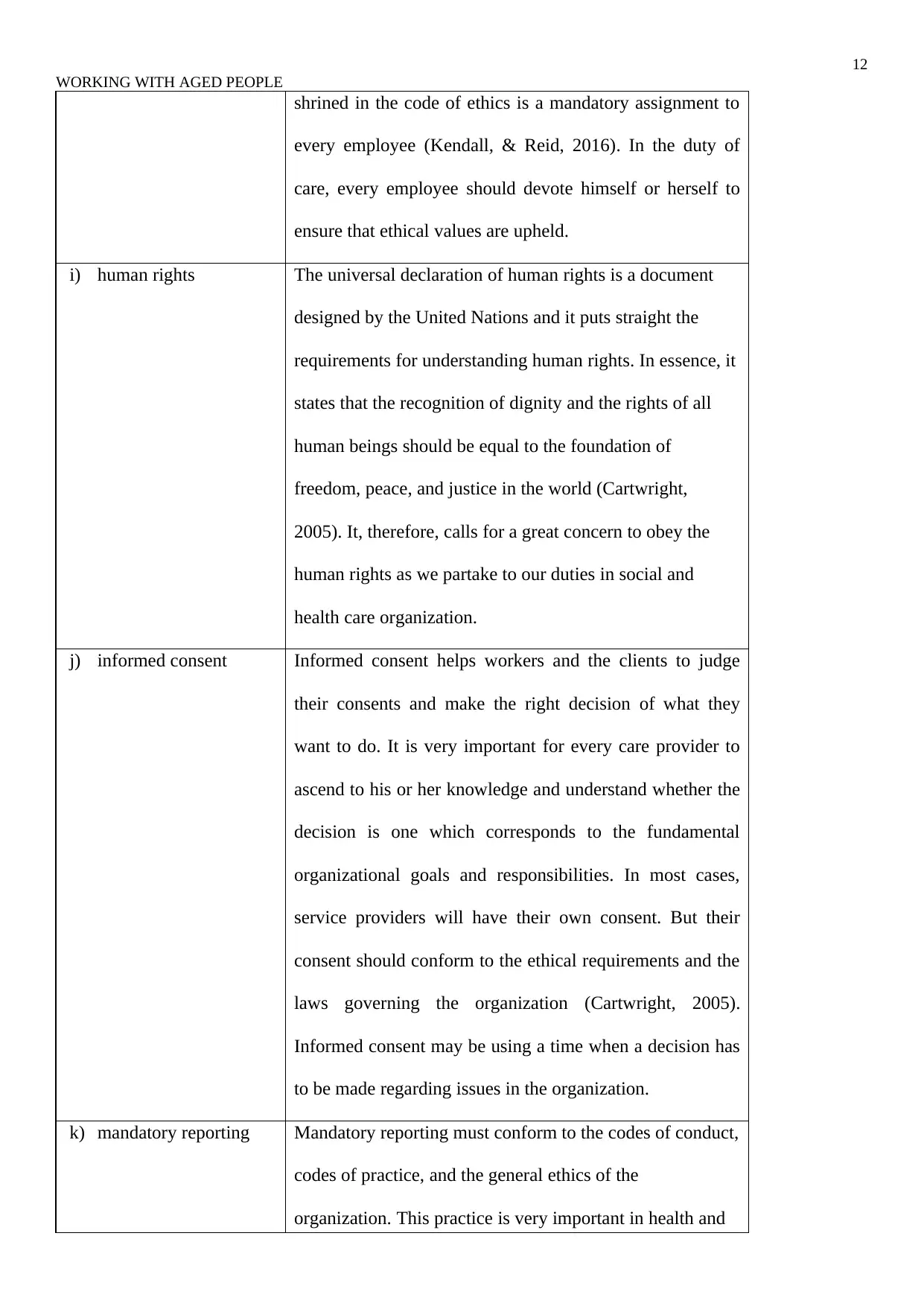
12
WORKING WITH AGED PEOPLE
shrined in the code of ethics is a mandatory assignment to
every employee (Kendall, & Reid, 2016). In the duty of
care, every employee should devote himself or herself to
ensure that ethical values are upheld.
i) human rights The universal declaration of human rights is a document
designed by the United Nations and it puts straight the
requirements for understanding human rights. In essence, it
states that the recognition of dignity and the rights of all
human beings should be equal to the foundation of
freedom, peace, and justice in the world (Cartwright,
2005). It, therefore, calls for a great concern to obey the
human rights as we partake to our duties in social and
health care organization.
j) informed consent Informed consent helps workers and the clients to judge
their consents and make the right decision of what they
want to do. It is very important for every care provider to
ascend to his or her knowledge and understand whether the
decision is one which corresponds to the fundamental
organizational goals and responsibilities. In most cases,
service providers will have their own consent. But their
consent should conform to the ethical requirements and the
laws governing the organization (Cartwright, 2005).
Informed consent may be using a time when a decision has
to be made regarding issues in the organization.
k) mandatory reporting Mandatory reporting must conform to the codes of conduct,
codes of practice, and the general ethics of the
organization. This practice is very important in health and
WORKING WITH AGED PEOPLE
shrined in the code of ethics is a mandatory assignment to
every employee (Kendall, & Reid, 2016). In the duty of
care, every employee should devote himself or herself to
ensure that ethical values are upheld.
i) human rights The universal declaration of human rights is a document
designed by the United Nations and it puts straight the
requirements for understanding human rights. In essence, it
states that the recognition of dignity and the rights of all
human beings should be equal to the foundation of
freedom, peace, and justice in the world (Cartwright,
2005). It, therefore, calls for a great concern to obey the
human rights as we partake to our duties in social and
health care organization.
j) informed consent Informed consent helps workers and the clients to judge
their consents and make the right decision of what they
want to do. It is very important for every care provider to
ascend to his or her knowledge and understand whether the
decision is one which corresponds to the fundamental
organizational goals and responsibilities. In most cases,
service providers will have their own consent. But their
consent should conform to the ethical requirements and the
laws governing the organization (Cartwright, 2005).
Informed consent may be using a time when a decision has
to be made regarding issues in the organization.
k) mandatory reporting Mandatory reporting must conform to the codes of conduct,
codes of practice, and the general ethics of the
organization. This practice is very important in health and
⊘ This is a preview!⊘
Do you want full access?
Subscribe today to unlock all pages.

Trusted by 1+ million students worldwide
1 out of 28
Related Documents
Your All-in-One AI-Powered Toolkit for Academic Success.
+13062052269
info@desklib.com
Available 24*7 on WhatsApp / Email
![[object Object]](/_next/static/media/star-bottom.7253800d.svg)
Unlock your academic potential
Copyright © 2020–2025 A2Z Services. All Rights Reserved. Developed and managed by ZUCOL.





